I
TYPES OF BEADS
W hile there is an almost limitless variety of beads, the principal kinds used in most beadwork are of a few well-known types.
Seed beads are small round beads about  inch in diameter, smooth and uniform in size. They are made in almost 350 different colors and shades, and are used for all kinds of woven work, for dress embroidery, and for beaded bags. Other, larger beads are also used for bags.
inch in diameter, smooth and uniform in size. They are made in almost 350 different colors and shades, and are used for all kinds of woven work, for dress embroidery, and for beaded bags. Other, larger beads are also used for bags.
Cut-lined and luster beads are about the same size as seed beads, but are made of clear glass and are usually six-sided. This gives them a rough surface and more sparkle than seed beads. The lined beads are lined with silver or gold. They are not used for weaving, but are good for necklaces and any decorative work that calls for small beads. These are sometimes called embroidery beads. They are made in about 400 different colors.
Embroidery cut beads or Charlottes are much smaller than seed beads and have facets instead of being smooth-sided. They are chiefly used by professional workers for very finely made handbags.
Bugle beads are made of colored glass and are cylindrical in shape. Their length varies from about  inch to nearly inch. They are useful for making bead flowers and figures, necklaces and bracelets, dress ornaments and bead furniture.
inch to nearly inch. They are useful for making bead flowers and figures, necklaces and bracelets, dress ornaments and bead furniture.
Tile beads are also cylindrical in shape, but are quite large, measuring about inch wide and inch high. As a rule, they are made of porcelain. They are used chiefly for making tile bead table mats and coasters, baskets, boxes and belts.
Round wooden beads are very attractive and brightly colored. They come in different sizes, from about inch in diameter up to inch or more. They are very good for making belts, necklaces, bracelets and handbags, and for decorative work.
In addition to round beads, there are many kinds of oval beads. They are used for jewelry of all kinds and for handbags and belts.
There are also many special beads, such as those made in the shapes of flowers. None of the articles described in this book call for the use of these beads, but if you become interested in beadwork you will probably want to use them in necklaces, bracelets and earrings.
Where To Get Beads. The most readily available places where you can find assortments of beads are ten-cent stores, department stores, and hobby supply shops. But the best way to become familiar with the hundreds of different kinds of beads that you can use is to get an illustrated catalog or price list from a bead manufacturer or importer. A very large proportion of the beads sold in the United States are made in other countries.
Some manufacturers and importers advertise in the hobby magazines. If these are not available to you, you can ask one of your local department stores or hobby supply shops if they can give you the names of the firms from which they buy beads.
The prices of commonly used types of beads are surprisingly low. Seed beads, cut-lined and luster beads, and bugle beads, for example, cost about 20 cents per 1,000. Many good-quality medium-sized beads of the kinds used in jewelry, belts and handbags cost less than a cent apiece.
II
BEAD WEAVING
B ead weaving or loom beading, as it is sometimes called, is one of the most popular methods of working with beads. It is a very old craft, which the American Indians have practiced for many centuries. The beads that are used for weaving are usually the small, so-called seed beads. These come in all the major colors, including gold.
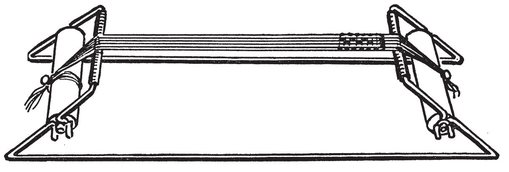
READY-MADE LOOMS
You can buy ready-made bead looms at stores that sell hobby and craft supplies. They are handy to use and usually are inexpensive, no more than a dollar or two.
Some people do not like these looms because they are almost always short and permit only about six inches of beadwork to be visible at any one time. The finished part of the work is rolled up on a spool at one end as the work goes along. Their shortness is not an important drawback, however, and ready-made looms can be recommended without hesitation for beginners or for those who do not want to go to the trouble of making their own loom.
BOARD AND BLOCK LOOMS
A 30-inch long loom made from a small board and two blocks of wood, such as the one shown in the drawing, will take care of practically every type of beadwork. It is long enough for headbands, belts and necklace chains, which are usually the longest articles woven with beads. The work and the colors can be seen and measured at all times. Also in a loom like this the beading can be started at the center and worked toward the two ends.
A board and block loom is easy to make. It is best to use some kind of hardwood for the two uprights, and care should be taken in making the fine notches for the warp threads. Use a good sharp knife for cutting the notches.
When the loom has been completed, it is a good idea to paint the bottom board black or dark brown. The beads will show up better against this dark background, and it will make the work a little easier.
BOX LOOMS
Box looms are easy to make and are perfectly adequate for every kind of bead weaving. Their only disadvantage is their short length.
Use a small wooden box about 12 or 15 inches long or, if you can get one easily, use a cigar box. Remove a part of the wood from the two sides to make room for your hand to pass under the beadwork while you are weaving.
Cut  inch deep notches in each end, spacing them
inch deep notches in each end, spacing them  inch apart, to hold the warp threads, that is, those that run the long way of the loom. An alternative method is to drive thin nails or brads into the ends of the box as close together as possible. If you use this method, try to leave just enough room for a thread to pass between each nail.
inch apart, to hold the warp threads, that is, those that run the long way of the loom. An alternative method is to drive thin nails or brads into the ends of the box as close together as possible. If you use this method, try to leave just enough room for a thread to pass between each nail.
Drive a large-headed nail into one end of the box, as shown in the drawing. Drive four large-headed nails into the opposite end of the box. These nails make it easier to handle the warp threads and keep them from getting tangled up. Instead of having to wait to secure the warp threads until you have put all of them in their notches, you can put three or four in the notches and secure their loose ends on one of the nails, and then go on to the next three or four.

A box loom has no roller on which to wind up the work as it progresses. So before you begin to weave, tie the warp threads together at one end to make a commencing knot, and this knot is slipped under the nail at the end of the loom. To move the work as needed, tie a piece of string to this knot. With this string the woven work can be drawn over the end of the loom, down over the end, and along underneath the box. The string is wound around one of the nails at the opposite end of the box. This makes it possible to weave a very long piece without the necessity of joining.

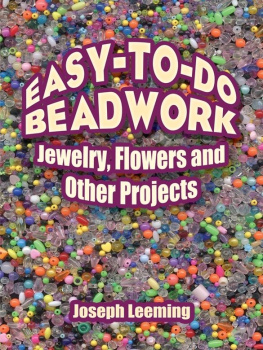
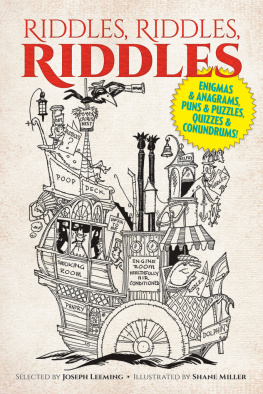



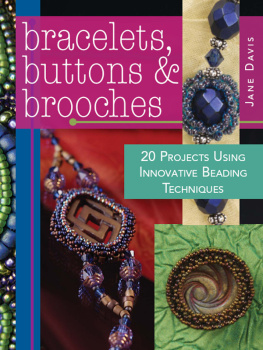
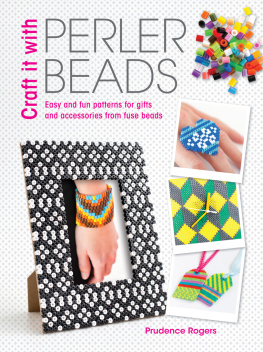
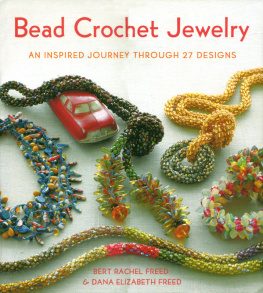


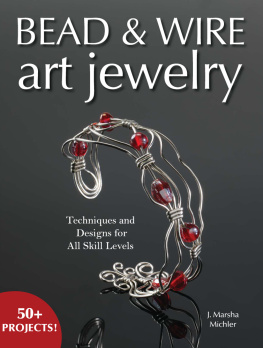
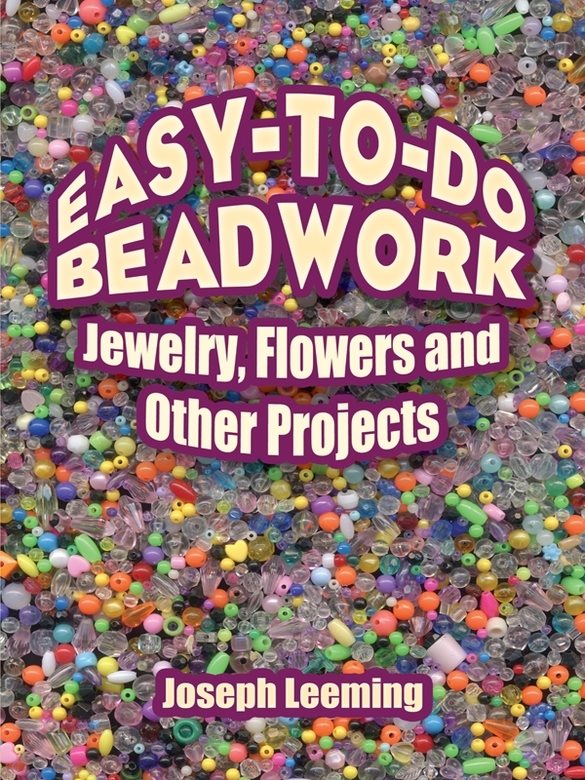
 inch in diameter, smooth and uniform in size. They are made in almost 350 different colors and shades, and are used for all kinds of woven work, for dress embroidery, and for beaded bags. Other, larger beads are also used for bags.
inch in diameter, smooth and uniform in size. They are made in almost 350 different colors and shades, and are used for all kinds of woven work, for dress embroidery, and for beaded bags. Other, larger beads are also used for bags.


 inch deep notches in each end, spacing them
inch deep notches in each end, spacing them  inch apart, to hold the warp threads, that is, those that run the long way of the loom. An alternative method is to drive thin nails or brads into the ends of the box as close together as possible. If you use this method, try to leave just enough room for a thread to pass between each nail.
inch apart, to hold the warp threads, that is, those that run the long way of the loom. An alternative method is to drive thin nails or brads into the ends of the box as close together as possible. If you use this method, try to leave just enough room for a thread to pass between each nail.